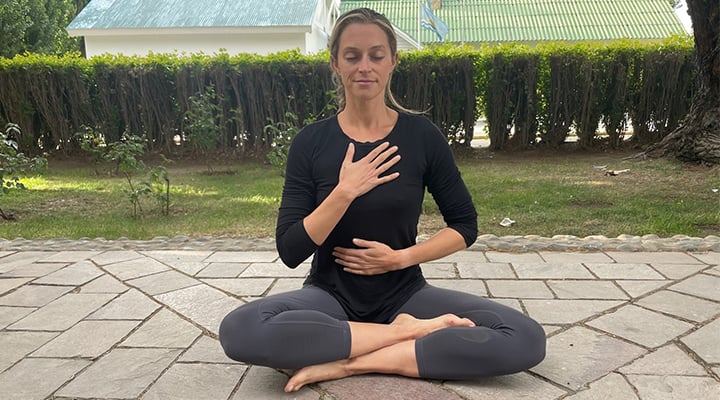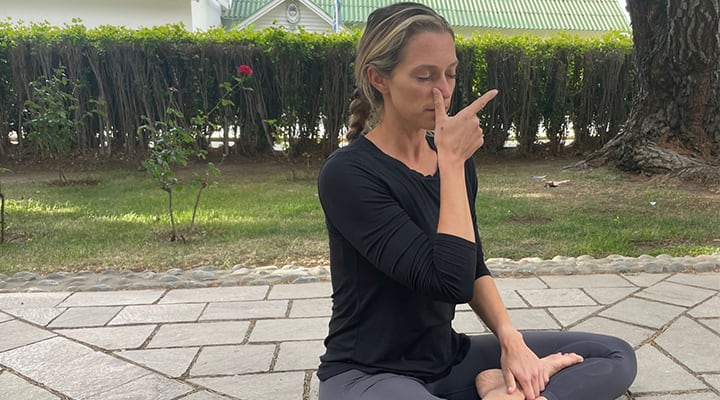
7 Breathing Techniques to Decrease Anxiety
Published: March 2023
When you’re working out, your body reacts. Your pulse starts pounding, your skin starts to sweat, and your breaths come faster. Taking shallow breaths is a normal, healthy reaction when you’re exercising, and it helps draw more oxygen into the lungs (and then get that oxygen to your hard-working muscles).
But outside the gym, shortness of breath may be a sign of anxiety or chronic stress, both of which can wreak havoc on your mental as well as physical health. Not to worry: We’ve got several breathing techniques to help you remember to take a deep breath and enjoy the moment.
What is diaphragmatic breathing?
Deep breathing, using your diaphragm to pull breath in, may be helpful to certain people, because deep inhales and long exhales help you relax when you are feeling physical or mental stress. Deep breaths lower your heart rate and blood pressure while getting your blood oxygen levels up.
How to practice deep breathing
Sometimes, we all need a reminder to stop and breathe. If you find yourself feeling anxious and short of breath, place one hand on your heart and one hand on your belly and breathe with your diaphragm. This diaphragmatic breathing (also called abdominal breathing or belly breathing) can help calm your respiratory rate and deepen shallow breathing.
Incorporating more calmness and zen in your day may also help you to be more mindful with your breathing. To do this, turn off technology. Find a peaceful space in your house or office to practice restorative yoga and deep breathing exercises. Go for a walk outside and breathe the fresh air. You have the power to make your life more relaxed, find your calm and manage your stress. (Just be realistic and patient with yourself!)
What are the advantages of deep breathing exercises?
Breathing exercises and diaphragmatic breathing help you relax your body and mind and may help you manage stress when you start to feel overwhelmed. And practice makes perfect: breathing exercises also can help make deep breathing easier and more natural.
How often should you do deep breathing exercises?
Experts suggest focusing on breathing exercises for 5-10 minutes several times each day, but deep breathing is encouraged any time you feel anxious or simply want a moment of calm. Daily exercise can help make deep breathing with your diaphragm more automatic, which contributes to healthy stress management and mood health.
Top 7 deep breathing exercises
Deep breathing techniques can help you relax in a variety of situations. Sit or lie down and focus on your breathing to get the most from these exercises.
Alternate Nostril Breathing:
This is a common yoga breathing practice that helps to promote relaxation.- Block one nostril at a time as you breathe fully in and out through the other nostril
- Alternate closing the left nostril with your thumb and then the right nostril with your ring finger as you breathe
Belly Breathing:
This breathing pattern is also called diaphragmatic breathing or abdominal breathing.- Place one hand on your heart and one hand on your belly
- Inhale a full breath through your nose for 4 counts
- Hold for a moment then slowly exhale fully for 4 counts
- Feel your abdomen expand and empty as you breathe
Box Breathing:
This breathing technique feels very rhythmic, and you can breathe with this pattern discreetly to encourage relaxation in almost any situation.- Inhale for 4 counts
- Hold your breath to retain the inhale for 4 counts
- Exhale for 4 counts
- Hold your breath for 4 counts
4-7-8 Breathing:
Another yoga-based breathing pattern, 4-7-8 breathing can be used to promote restful sleep.- Press the tip of your tongue against the ridge of tissue behind your upper front teeth for the duration of the exercise
- Close your mouth and inhale quietly through your nose for 4 counts
- Hold your breath for 7 counts
- Exhale completely through your mouth for 8 counts, making a whooshing sound
Lion's Breathing:
Some choose to breathe this pattern while in a tabletop or seated yoga position.- Inhale deeply through your nose
- As you exhale, open your mouth and let your tongue hang heavy while you let out an audible breath
- This breathing exercise helps relax the jaw and facial muscles
Mindfulness Breathing:
This deep breathing technique focuses on mental health rather than a specific way to breathe.- Breathe comfortably and focus your attention on being present in the moment
- This breathing can include a calming sound (like “om”) or a word (peace, calm, happiness).
Pursed-Lips Breathing:
This is another breathing exercise that can be used to promote relaxation and stress management discreetly.- Inhale through your nose
- Exhale through pursed lips (like a kiss)
- Make your exhale twice the length of your inhale
About the Author: Based in South Florida, Mallory Hope is a certified practitioner of yoga therapy, which enables yoga postures and yoga logic, breathing and meditation to create a unified mind/body connection and to facilitate the internal and external healing of the body. She is 200 Hour RYT, Yin Certified, Meditation Certified and Barre Certified. You can find her on Instagram at @malloryhopes.
References
- Hopper, Susan I, et al. “Effectiveness of diaphragmatic breathing for reducing physiological and psychological stress in adults: a quantitative systematic review.” JBI Database System Rev Implement Rep. September 2019. https://pubmed.ncbi.nlm.nih.gov/31436595/
- Magnon, Valentin, et al. “Benefits from one session of deep and slow breathing on vagal tone and anxiety in young and older adults.” Sci Rep. September 2021. https://pubmed.ncbi.nlm.nih.gov/34588511/
- Rogers, Kristen. “The 4-7-8 method that could help you sleep.” CNN. February 2023. https://www.cnn.com/2022/09/16/health/4-7-8-breathing-technique-relaxing-wellness
- “Breathing Exercises.” American Lung Association. https://www.lung.org/lung-health-diseases/wellness/breathing-exercises
- “Pursed Lip Breathing.” Cleveland Clinic. https://my.clevelandclinic.org/health/articles/9443-pursed-lip-breathing
Always be in the know!
Access the latest deals, wellness news, expert health tips & more!






